Launching a Martin Mars - 16 June 2006
In June 2006, I visited western Canada, chasing air tankers and float planes. Mainly Beavers and Otters, the odd Beech 18 on floats and a few other gems, but also the ultimate combination of air tanker and flying boat, the magnificent Martin Mars. If you want to know more about these gigantic 61-year old flying boats, check out my article on the Martin Mars.
Of course we were hoping we would be lucky enough to see the two aircraft in action. We were not. Instead, we found red-tailed C-FLYL 'Hawaii Mars' floating around its mooring buoy in Sproat Lake on Vancouver Island, and white-tailed C-FLYK 'Philippine Mars' parked ashore on its beaching gear at the Port Alberni/Sproat Lake Tanker Base (CAA9). We took plenty of photos of both aircraft, and were just about to leave for Campbell River, when one of the technicians working on Philippine Mars remarked to us: "We're going to put her in the water in about an hour or so." Of course, with a launch of a Martin Mars being a pretty special and rare occasion, this was music to our ears, and obviously more than enough reason to postpone our departure!
Below is a photographic report of what happened next. The lauching of a Martin Mars turned out to be a careful process, slow and very exact. These aircraft are truly treated with the utmost respect, and everything is done with the greatest of care. In this case, the operation was hampered by a rather strong crosswind blowing from the southwest. The crew manning the two boats, which have to quickly tow the Mars away from the shore once it's free in the water, told us they were a bit nervous about it, afraid the strong wind might blow the aircraft against the pier if things didn't go right. One of them commented to us: "This is either going to be very boring or very exciting!"... For us it would turn out to be the latter, but not for the reasons he meant.
So, here are the photos of this memorable event. Don't forget to click on the pictures to see a larger image!
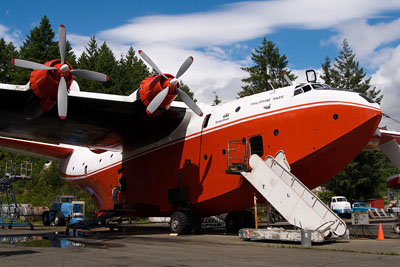 |
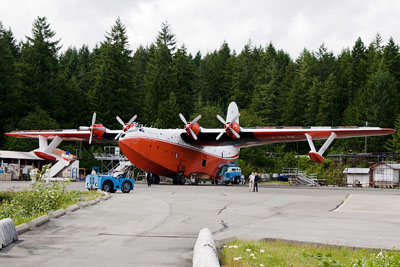 |
| 14.53: Philippine Mars is still being worked on. The engineer working on the rear fuselage looks tiny next to the world's largest operational flying boat. | 15.30: All equipment has been removed or moved aside, and Philippine Mars is very slowly and carefully being pushed towards the water. Remember this aircraft's wingspan is larger than that of a Boeing 747-300! |
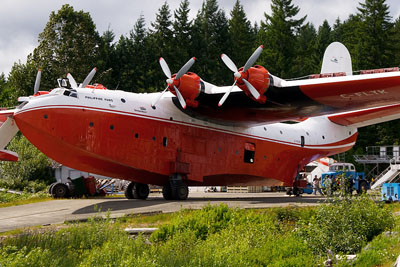 |
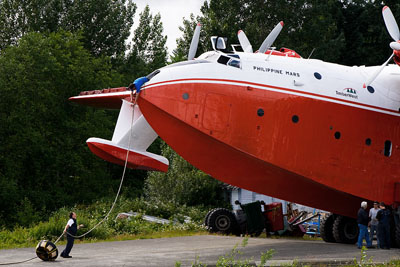 |
| 15.38: Slow and easy... It took about 10 minutes to traverse the 40 or so meters to get to the launch ramp. And this was just the easy part, now the first of the two difficult parts begins... | 15.50: Attaching the steering cable, which will be used to keep Philippine Mars on track as it is lowered down the launch ramp. This cable runs to a pulley in the water straight in front of the launch ramp, and from there below the ground back to the main ramp, where it is attached to a second truck. |
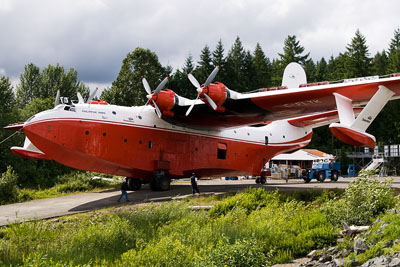 |
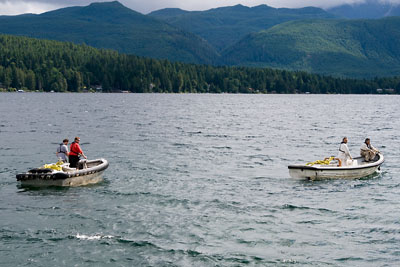 |
| 16.03: The tow truck has been turned around and secured, and is now using its winch to very slowly lower Philippine Mars down the ramp under its own weight. The steering cable is kept unslacked by a slowly advancing second truck on the ramp. | 16.08: The guys in the boats are watching the activities on the ramp while waiting for their turn. They are ready to quickly tow the aircraft away from the shore as soon as it's free in the water. |
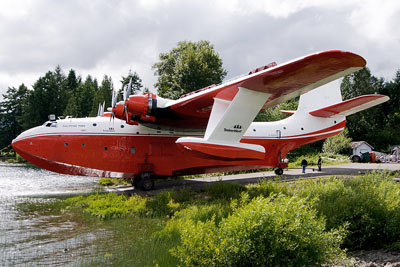 |
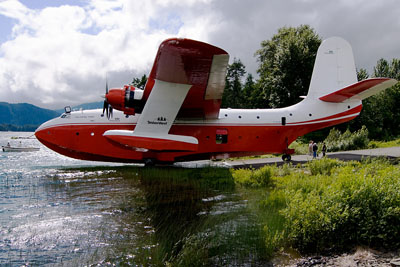 |
| 16.11: Philippine Mars is anxiously sniffing the water, probably for the first time this year. | 16.16: So far, so good... The Mars made it down the ramp, and is now getting its feet wet, carefully as always. |
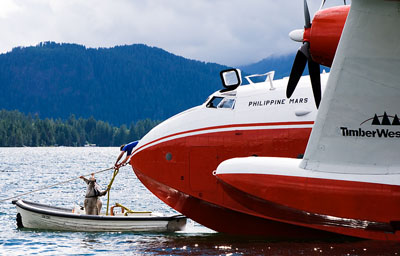 |
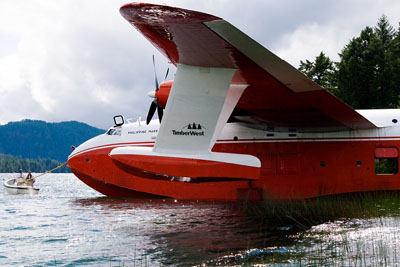 |
| 16.24: Here starts the second tricky bit, even more so because of the rather strong wind. The beaching gear of Philippine Mars is still on the ramp, but not for much longer. The steering cable is now released, and another cable is used to attach the Mars to the boat. | 16.26: The boat is already pulling, steering into the strong crosswind, to get the Mars away from the ramp the moment it starts to float freely. |
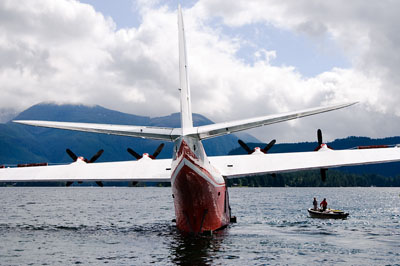 |
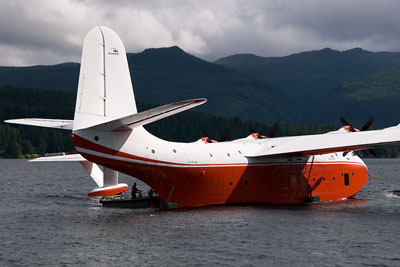 |
| 16.28: And there it goes! Safe in the water, where it belongs when not in the air, a full hour after the lauching started. I am sure the Flying Tankers guys in the boats and on the ramp all breathed a sigh of relief... | 16.31: With the mooring point being more or less downwind from the ramp, the next part is simple: just let the wind blow Philippine Mars there. An occasional and gentle steering nudge by one of the boats is enough to keep the aircraft on course. |
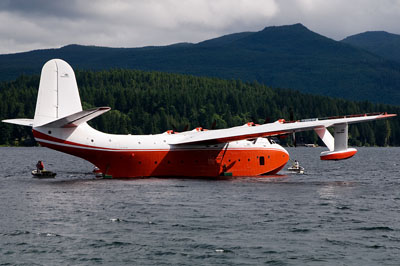 |
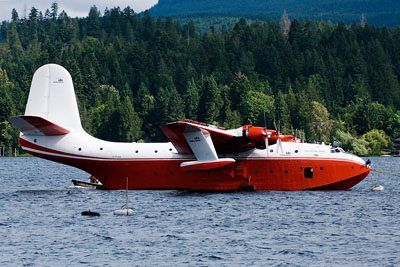 |
| 16.33: Almost there... | 16.40: The final step: Philippine Mars is attached to its mooring buoy. |
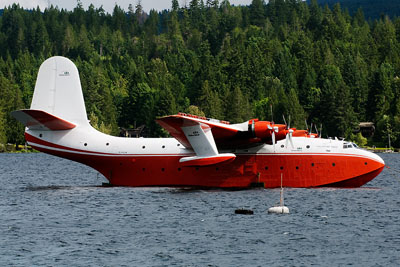 |
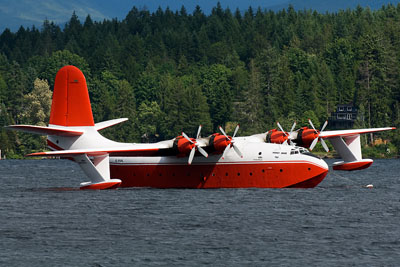 |
| 16.49: And there it is, all ready and closed up for today, gently pulling its mooring line. I wonder why they left the beaching gear attached though... | And all the while Hawaii Mars has been quietly watching all the activities from its nearby mooring point. |
| These two photos clearly show the differences between C-FLYK Philippine Mars on the left and C-FLYL Hawaii Mars on the right. Except for the tail colours, also note the drop doors on Philippine Mars, which are absent on Hawaii Mars, because of the different drop mechanisms. For more info on this, see my article on the Martin Mars. | |
Obviously these two rare flying boats, relics from a time long gone, have been lucky to have belonged to this company and its predecessors for the past 47 years. The professionalism and Tender Loving Care we witnessed today has kept these two veterans flying for a time much, much longer than the engineers at the Glenn L. Martin Company could ever have imagined 61 years ago. We, the aviation enthusiasts of today, are lucky too.
